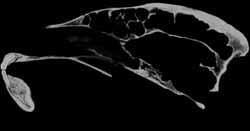Crocuta crocuta, the spotted hyena, is generally found in the open habitats of Africa south of the Sahara. During the Pleistocene, its range also included Eurasia. Crocuta is a social carnivoran, for it is organized into matrilineal clans that are comprised of 8 to 80 individuals. Crocuta is an active hunter, not simply a scavenger. Its diet is dominated by medium-sized ungulates such as wildebeest and zebra. Crocuta consumes all parts of a carcass. Enlarged premolars and a robust skull facilitate the processing of bone by Crocuta. |
|
Data from CT scans of the skull and jaws of Crocuta provide important information that complements growth studies. Bite strength and feeding behavior are affected by growth, which is important to young Crocuta making the transition to adulthood. The jaws of adult Crocuta are designed to withstand the forces produced when the animal employs the killing bite with the canines and the cracking of bones with the premolars. Crocuta dentaries are thickened with compact bone below and behind the premolars. This morphology acts as a buttress against bending during unilateral biting of tough foods such as bone.
The crania of adult Crocuta exhibit elongated sinuses in the frontals and parietals, which extend completely over the brain cavity. This remarkable morphology is also present in Hyaena hyaena (striped hyena) and Parahyaena brunnea (brown hyena), and Adcrocuta eximia (extinct hyaenid). Recent research conducted by Joeckel (1998) included CT scans and suggests that the elongated sinuses create a geometry that provides better resistance to the loads placed upon the skull by the jaw-closing muscles.

About the Species
This specimen (MVZ 184551), a male, was collected by L. G. Frank on 30 March 1993 at Talek Gate, Masai Mara National Reserve, Kenya, Africa. It was made available to The University of Texas High-Resolution X-ray CT Facility for scanning courtesy of Dr. James L. Patton of the University of California Museum of Vertebrate Zoology. Funding for scanning was provided by a National Science Foundation Digital Libraries Initiative grant to Dr. Timothy Rowe of The University of Texas at Austin.

About this Specimen
The specimen was scanned by Richard Ketcham and Matthew Colbert on 16-17 September 1999 along the coronal axis for a total of 527 slices. Each 512x512 pixel slice is 0.5 mm thick, with an interslice spacing of 0.5 mm and a field of reconstruction of 166 mm.
 |
To the left is a reduced sample slice through the skull (showing the anteroposterior extent of the elongated frontal sinuses). Click on the thumbnail to view an unreduced version. |

About the
Scan
Literature
Biknevicius, A. R., and C. B. Ruff. 1992. The structure of the mandibular corpus and its relationship to feeding behaviours in extant carnivorans. Journal of Zoology (London) 228:479-507.
Binder, W. J., and B. VanValkenburgh. 2000. Development of bite strength and feeding behaviour in juvenile spotted hyenas (Crocuta crocuta). Journal of Zoology (London) 252:273-283.
Buckland-Wright, J. C. 1969. Craniological observations on Hyaena and Crocuta. Journal of Zoology (London) 159:17-29.
Joeckel, R. M. 1998. Unique frontal sinuses in fossil and living Hyaenidae (Mammalia, Carnivora): description and interpretation. Journal of Vertebrate Paleontology 18:627-639.
Kruuk, H. 1972. The spotted hyena. A story of predation and social behavior. The University of Chicago Press, Chicago. 335 pp.
Werdelin, L., and N. Solounias. 1991. The Hyaenidae: taxonomy, systematics, and evolution. Fossils and Strata 30:1-105.
Links
The brain of Crocuta crocuta Comparative Mammalian Brain Collections Website
Crocuta crocuta on The Animal Diversity Web (The University of Michigan Museum of Zoology)
Crocuta crocuta on CalPhotos.

Literature
& Links
None available.

Additional
Imagery
|

